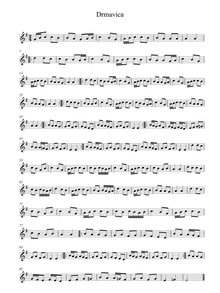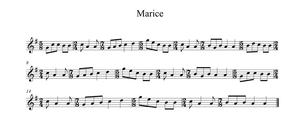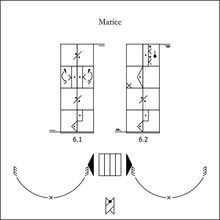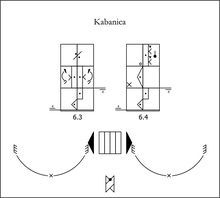DRMAVICA
Folk memory recognizes several, sometimes similar dances under the term Drmavica. The name refers to an essential feature of the Bosnian dances, the tremble (drma).
Todore is mentioned by the name Po jedan put drmavica, as there is a repeated tremble in the dance. Na dvi strane kolo, as well as Kabanica, is meant by Po dva put drmavica (the number 2 in the former one denotes the number of trembling steps taken to the left, while in the latter it means the two jolts, i.e the knee-bend, at the end of the step pattern). Po tri put drmavica is another name for Marice kolo, while Po pet put drmavica for Kabanica (numbers 3 and 5 refer to the number of steps). Kratka drmavica or Dugačka drmavica names are also used for Marice, Kabanica, and Trojanac. The way of counting among folk people sometimes produces something peculiar; Kabanica is also known as Po sedamput drmavica, because, although it consists of 12 beats, the counting goes to 7 je-dan-dva-tri-čet-ri-pet-šest (these are quaver notes), and -se-dam (quarter notes).
We must differentiate two types of Drmavica as for the dance steps, structure, and the melodies: the Marice kolo and the Kabanica. Both are danced in a closed circle, by men and women alike, with Kolo hold, stepping either only to the left or symmetrically, to the left then right. Long verses of songs are attached to both; the names Marice and Kabanica themselves refer to the lyric (Oj, curice, Marice...; or Kabanica od seksera haj, haj...).
The motifs of Marice kolo (Po tri put drmavica) are characterized by the small traveling steps danced on the whole foot, together with the intensive, but small and strong trembles, touching the ground. Kabanica (Dugačka drmavica) is also featured by this style, though it contains longer motifs. Marice kolo is considered a Bosnian dance (kupusarsko) by the village Sokac. They are the closest to the Bosnians (as for their settlements, folk costume, dances, songs, and traditions), while they view Kabanica as their own. It is mentioned as a Pécsudvard dance (udvarski ples) together with Na dvi strane kolo by people from other villages.
Here we should mention some words about Pécsudvard. Stipan Pavković Patak, the outstanding musician, the virtuoso fiddler of the Bosnians, lived in the village in the 1950s and early 60s. He and his band were well-known in Baranya county. The Bosnian communities considered his exceptional music as their own. During his work, Pécsudvard became the leader and style-setter in music and dance culture among the neighboring Bosnian villages. He was a good dancer, too. As he played in many-a-places (e.g., in Bačka), the Bosnians got to know several dances through him.
Musical parallels of Marice kolo are easily found in Slavonia (Dorata) and along the river Drava. The dance Ime moje in Central Bosnia has a similar tune, which is interesting, as it seems to have been linked to the motherland.
Sitne bole is a Kabanica style dance of the Drava river Sokac. Its melody is part of Patak Drmavica’s tune. The girls in Pogány sang as follows: Mužikaj nam sitne bole racke, da igraju curice poganske! The relationship between the two dances (Sitne bole, Kabanica) are inevitable (common origin, or descending from one another).
MUSIC
VIDEO







